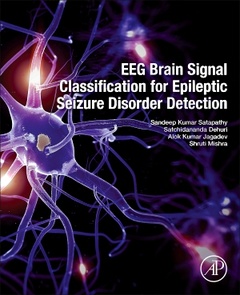Description
EEG Brain Signal Classification for Epileptic Seizure Disorder Detection
Authors: Satapathy Sandeep Kumar, Dehuri Satchidananda, Jagadev Alok Kumar, Mishra Shruti
Language: English
Subjects for EEG Brain Signal Classification for Epileptic Seizure...:
Keywords
ABC; Artificial bee colony (ABC); Artificial neural network (ANN); Brain computer interface (BCI); Continuous wavelet transform (CWT); Discrete wavelet transform (DWT); EEG; Electroencephalogram (EEG); Epilepsy; Epileptic seizure; Feature extraction; Fourier transform (FT); Machine learning; Neural network (NN); NN; Particle swarm optimization (PSO); PSO; Radial basis function (RBF); Radial basis function neural network (RBFNN); RBFNN; Recurrent neural network (RNN); Support vector machine (SVM); Support vector machines (SVMs)
107.04 €
In Print (Delivery period: 14 days).
Add to cart134 p. · 15x22.8 cm · Paperback
Description
/li>Contents
/li>Readership
/li>Biography
/li>Comment
/li>
EEG Brain Signal Classification for Epileptic Seizure Disorder Detection provides the knowledge necessary to classify EEG brain signals to detect epileptic seizures using machine learning techniques. Chapters present an overview of machine learning techniques and the tools available, discuss previous studies, present empirical studies on the performance of the NN and SVM classifiers, discuss RBF neural networks trained with an improved PSO algorithm for epilepsy identification, and cover ABC algorithm optimized RBFNN for classification of EEG signal. Final chapter present future developments in the field.
This book is a valuable source for bioinformaticians, medical doctors and other members of the biomedical field who need the most recent and promising automated techniques for EEG classification.
1. Introduction2. Literature survey3. Empirical study on the performance of the classifiers in EEG classification4. EEG signal classification using RBF neural network trained with improved PSO algorithm for epilepsy identification5. ABC optimized RBFNN for classification of EEG signal for epileptic seizure identification6. Conclusion and future research
Dr. Satchidananda Dehuri is working as an Associate Professor in the Department of Information and Communication Technology, Fakir Mohan University, Balasore, Odisha, India. Prior to this appointment, for a short stint (from Oct. 2012 to May 2014) he was an Associate Professor in the Department of Systems Engineering, Ajou University, South Korea. He received his M.Tech. and PhD degrees in Computer Science from Utkal University, Vani Vihar, Odisha in 2001 and 2006, respectively. He visited as a BOYSCAST Fellow to the Soft Computing Laboratory, Yonsei University, Seoul, South Korea under the BOYSCAST Fellowship Program of DST, Govt. of India in 2008. In 2010 he received Young Scientist Award in Engineering and Technology for the year 2008 from O
- Explores machine learning techniques that have been modified and validated for the purpose of EEG signal classification using Discrete Wavelet Transform for the identification of epileptic seizures
- Encompasses machine learning techniques, providing an easily understood resource for both non-specialized readers and biomedical researchers
- Provides a number of experimental analyses, with their results discussed and appropriately validated



